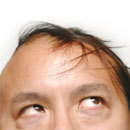The 5 Most Ridiculous Things People Tried to Patent

Creating something new is hard. It's certainly much easier to patent things that have already been invented, which is exactly what these people did.
Toast
Visionary genius Terrance F. Lenahan saw an opportunity for glory in 1999 when he applied for a patent for a new way of cooking bread:
"A method of refreshening a bread product by heating the bread product to a temperature between 2500 F. and 4500 F. maintained at this temperature range for a period of three to 90 seconds."

"This is going to change the world."
You may recognize this process as "toasting," which is something people have been doing since the invention of bread and fire. Don't think switching up the bread involved will get you off the hook, either -- Lenahan was careful to ensure that his patent covered every form of toastable breakfast grain:
"The method of claim 1 including the step of selecting said bread products from rolls, muffin, buns, and bagels."

"Baguettes can eat a dick."
Technically, every time you put a slice of bread in a toaster (an invention that was likewise created without Lenahan's consent), you owe him money.
Short Business Meetings
Back in 2009, IBM noticed that employees would take up the entire hour of a scheduled business meeting, even if they didn't have an hour's worth of things to discuss. After careful thought, they sagely concluded that:
"... if an hour were shorter, by a small amount, we would be more focused, and accomplish the same amount of work, but in less real time, thereby increasing productivity."

"... and if we cancel the meetings, productivity increases even further!"
So, they just started scheduling shorter meetings, right? Well, that quote is actually from IBM's patent application for the very idea of shorter meetings itself, because for some inexplicable reason they figured they were the first institution to ever have this breakthrough. Basically any meeting shorter (or longer) than an hour and the accompanying software used to schedule it is covered in their exhaustively detailed "System and Method for Enhancing Productivity" patent. They are either completely unaware of how ridiculous claiming ownership to an abstract concept is or totally aware and just wanted to see if it would work.

"Next, we'll patent hating every new day more than the last."
Comb-Overs
In 1977, Frank Smith found that he was going bald and began boldly covering up his naked pate with dramatically overgrown lengths of his own hair. This method of hair fakery is commonly called a comb-over, and people have been doing it for about as long as they have been making toast. Undaunted, Smith applied for a patent for his genius technique, and because the universe routinely makes absolutely no sense at all, he was granted one. In his defense, Smith's comb-over application is staggeringly thorough, so he is arguably due a place of some distinction in the comb-over's venerable history.

"As long as I maintain this position, no one will know my shameful secret."
Patenting
Proving that you can get anything patented as long as you make it sound complicated enough, in 2007 Halliburton filed for a patent ... for patents. No, seriously. Stay with us here.

"Next we'll patent patenting patents, and then THE WORLD IS OURS!"
Basically, the patent they filed would grant them "patent acquisition and assertion ... against a second party," and would "cover a product of the second party where the product includes a secret aspect. The methods further include filing the claim with a patent office." This is the literal definition of a patent itself. Furthermore, the application includes phrasing that would allow them to patent things they hadn't even invented, which elevates Halliburton's patent antics from run-of-the-mill duplicity to heroic douchebaggery.
The Pyramids
It would probably never occur to most of us to try to patent one of the Seven Wonders of the Ancient World (although the Hanging Gardens of Babylon are ripe for the taking), and that's because it almost certainly wouldn't work. Unless you tried to do it indirectly, which is what inventors Daniel Dudek and Pamela Heard did when they applied for a patent for pyramids in 2002. And it totally worked.

"This oddly shaped mountain gives me an idea!"
Brilliantly, the patent never actually uses the word "pyramid" -- it simply describes a "burial structure for the interment of human remains and significant memorabilia providing space for multiple human remains ." The structure "prohibits access to the individual cremens or bodily remains , allows the forming of the mausoleum into innovative designs and shapes , and is kept safe from vandals and other intrudes ."
And here's one of the drawings they submitted with the application:

Great minds think alike. And several thousand years apart.
That is a mummy-laden stone tepee if we've ever seen one.